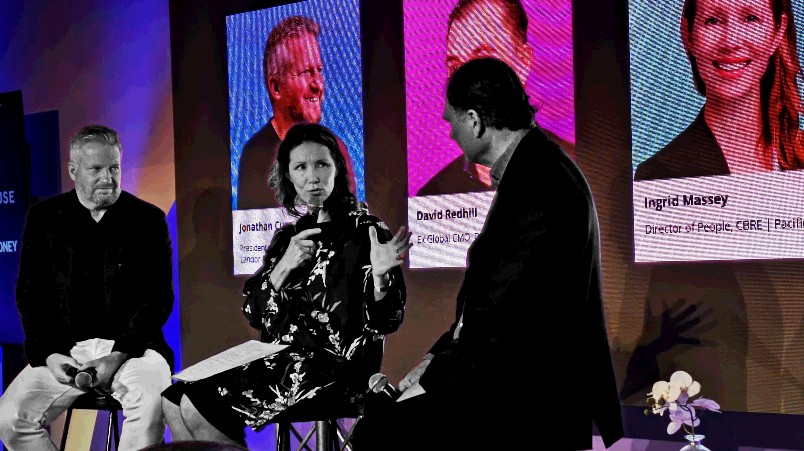Marketing and people leaders can hold the c-suite accountable – and avoid the knife – if they work together; it’s time they drove better functional alignment
An Mi3 editorial series brought to you by
7 / 7plus


By putting their heads together and aligning behind brand, marketing and people leaders have the power to deliver significant impact, growth and differentiation for an organisation. It’s a functional alignment that’s even more critical when times get tough or that complex M&A deal is underway, CBRE’s people chief and Deloitte’s former CMO agree. But it’s an alignment that’s still lagging, if the discrepancies between external and internal brand work is anything to go by, Landor & Fitch says.
Together, the CMO and chief people officer have the power to hold the rest of the c-suite to account and drive continued investment in people and brand through tough times, former Deloitte CMO David Redhill, believes.
The respected marketing and brand leader was part of trio on stage at SXSW Sydney discussing the symbiotic relationship between marketing and people functions, and why it’s more important than ever for these two teams to collaborate and align, using brand as their foundation. He was joined by CBRE chief people officer, Ingrid Massey, and Landor & Fitch APAC president, Jonathan Cummings.
It’s easy to see how growing impetus for businesses to exhibit purpose brings these two functions together. Figures highlighted by Landor & Fitch show 63 per cent of customers purchase from brands that stand for a purpose aligning with their values and beliefs, while 77 per cent of purpose-aligned employees are engaged and loyal advocates for their organisations.
The fact marketing and HR are both in the business of people and engagement is another resemblance. During the panel session, Massey even used what has become a common marketing refrain, “understanding the frustration points and moments that matter”, to describe her own dealings with change when rolling out new technology and ways of working across an organisation.
What’s more, marketing and people functions share similarly oriented measures of success such as customer versus employee churn, customer lifetime value versus average tenure, NPS versus eNPS, and customer loyalty versus engagement and trust.
Yet as Cummings noted, audiences and employees are still commonly treated distinctly, with the result being internal and external brand manifestations that pull in different directions.
“To make the promise the CMO is making to audiences stick outside the business, you have to get people onboard inside the business and vice versa – the people team needs to communicate, engage and design structures internally that can enable the marketing promise to be met internally and externally,” Redhill told attendees.
“If leaders recognise it’s a holistic pursuit to deliver on brand promise, and everyone has to play a part, then marketing is not just for marketing, and HR is not for HR, brand becomes a construct everyone can fulfil.”
Keeping brand alive in tough times
It’s one thing to build and align behind brand in good times. The bigger question is how brand investment and people management fare when things aren’t so rosy. Take the uncertain economic times we’re experiencing right now.
“Brand can instill pride and motivation inside the organisation and extract discretionary effort, which is priceless,” Redhill responded. “Ultimately, the CMO’s role is to try and make themselves redundant and turn an entire workforce into marketers. This is where brand delivers.”
Yet when times are tough, the instinct of the CFO is to cut costs – and marketing is the overhead.
“I think the chief people officer and the CMO can make a very powerful partnership in holding the rest of the c-suite to account but also in making case for continued investment in people and brand through tough times like that,” Redhill continues.
Another tool marketing and people leaders jointly wield is an ability to engage an organisation’s employees to help solve problems when the c-suite is faced with uncertainty, Redhill said. He pointed to the internal ‘Dummest things we do’ campaign during his time at Deloitte as an example of building rapport with employees to improve business and brand outcomes.
“We said we know we do so many things wrong, so rather than complain around the water cooler, help us fix them. We ran a survey through online blogs and collected several thousand ideas, which we put into three buckets: Those we could solve immediately; those that needed a long-term strategy that we agreed with; and those we have to live with but acknowledged. That was a way of tapping into the intelligence and emotion of several thousand people to engage them,” he said. “That helped inform the strategy and bind the leadership ideal and goal of the business with the reality of people contributing to the way it was working.”
The third non-negotiable in ensuring external brand promise matches up to internal reality is transparency from the c-suite down on intent.
“In tough times, when one arm of the business is saying everything is rosy, we’re protecting jobs, then there is the night of the long knives and people start disappearing, it demoralises,” Redhill said. “Look at Twitter – that demoralised an entire workforce and discredited the brand in many ways. It’s a case study in how not to take your workforce with you. In a people, service and product business, your people are helping you deliver on the promise. If you’re falling short of that, boom; you know where that brand is going.”
During her time at Qantas, Massey experienced the power of brand and transparency firsthand when the airline laid off 5,000 workers to weather the competitive assault launched by Virgin Airlines.
“Messaging was clear all the way from top – to managers having closed group conversations, to broader conversations. We needed to make sure all messaging was on point, because the moment we emailed it, it was on the front page of the SMH. And we were losing family members – the average tenure was 14 years then. It was a really tough time,” she said. “It was about retaining pride and making it clear that if we hold strong to the brand, and we keep aligned with our original purpose and mission, this too shall pass.”
Other critical factors included strong change practices, being authentic and transparent on intent and sticking to the long-term vision “so we will rise again”, she added.
Everything is getting politicised. Even a simple issue like sustainability and the health of planet seems to divide people on a certain level. Just about every other issue you care to name can be totemised and wrapped into a political mask. But it’s a mistake from leaders to resign from that opportunity and challenge to distill what is the essence of the business and to express, differentiate and deliver that in a relevant way. That’s what good brands do.
What’s preventing marketing-people alignment
So how do you foster marketing and people leadership connection? For Massey, the “bump factor” of working alongside marketing and brand teams physically over the years has proven invaluable. Ensuring KPIs are tailored towards teams and collaboration is another way of bringing functions together. There’s also a lot to be said for providing forums for sharing and exposing concepts you are grappling with as a people leader with your marketing counterpart and “walking a mile in the other person’s shoes”.
“I’ve never sat down in my roles and not gone through customer brand sentiment surveys, asking how we bring that customer voice into our people,” Massey said. “Our people are brand ambassadors. I’d also think about our practices, the strategic partnerships bringing data and insight to our external customers, plus our external value proposition and how we bring that into the internal space.”
With 55 per cent of CBRE’s workforce millennial age or younger, Massey recognised a growing need for brand purpose to manifest on the ground and through the actions of a business as a critical recruitment and retention lever.
“These are people approaching organisations for standing up for social matters, more than just ticking the box. Brand isn’t just ESG, DEI – it’s something you live and breathe on the floor,” she said. “We need to not just make the claims but to role model, walk the talk, and bring that through the organisation.”
It’s also crucial given 84 per cent of potential talent makes a decision about an organisation based on word-of-mouth.
“If you’re in a war for talent and you’re trying to attract, you need your entire workforce out there saying great things about you at that BBQ,” Massey said.
Shying away from brand differentiation on purpose
Yet even as the impetus for brand purpose and differentiation gain importance, panellists admitted many organisations are shying away from exhibiting a differentiated position on matters like sustainability or DEI for fear of sticking their heads above the parapet.
“It’s increasingly a challenge for building brand equity and increasing risk for getting wrong,” Redhill agreed. “Everything is getting politicised. Even a simple issue like sustainability and the health of planet seems to divide people on a certain level. Just about every other issue you care to name can be totemised and wrapped into a political mask.
“But it’s a mistake from leaders to resign from that opportunity and challenge to distill what is the essence of the business and to express, differentiate and deliver that in a relevant way. That’s what good brands do. I bring it back to the Bill Bernbach quote: If you stand for something, you will always find some people for you and against you. If you stand for nothing, you will find nobody against you, and nobody for you. People won’t care.”
That doesn’t mean deliberately polarising opinion in market, Redhill said. “You can still play to themes of humanity, compassion, the betterment of the human condition everyone agrees with. It might be worth starting with the end idea, and what is to everyone’s benefit, and work backwards and meet in the middle on where your strategy lives. Otherwise, you risk mediocrity, and not making a difference. No business wants to be in that position.”
